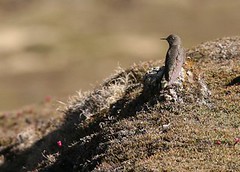
Olivaceous Thornbill (Chalcostigma olivaceum)
Originally uploaded by rgibbo3
I finally got an OK photo of this outstanding bird. The Olivaceous Thornbill is one of two hummingbirds I see regularly in my study sites. This field season I had the help of two Peruvian botanists; they were extremely knowledgeable and answered all my pesky questions. The small red flowers in the photo are one of three species of Gentianella; each of the three species has a different color: red, fuschia, and purple. Every time I found Olivaceous Thornbill, there was a patch of Gentianella close by. I believe this and insects are the majority of its diet.
There are reports of this species walking, but in the twenty or so times I've seen it, it has always fluttered rather clumsily from one flower to the next alighting on the ground. I would really like to see a video clip of this species walking.
Although you can't see it in this photo, the male has a narrow gorget that shimmers a brilliant spectrum of colors if at just the right angle. I'll have to keep trying for that shot.

6 comments:
A 2001 DNA study (von Hagen & Kadereit) led to the authors' following comment: "The high specific diversity of Gentianella in South America probably resulted mainly from the availability of a very large alpine area open to colonization rather than from particularly high speciation rates in comparison to other taxa." Do you have any observation records that indicate that the three associated Gentianella species are hummingbird-pollinated?
I believe they are all humingbird pollinated. The short stalked flowers are a perfect fit to the short bills of the "thornbills". Interesting!
...further, I would have to consider the possible role of climate as an isolating mechanism as the niche envelope of this genus contracted and expanded during the last 100,000 years. I wonder if they did a molecular clock estimate for the age of this species. Do you have the pdf? A citation would be appreciated if not.
And yes, I've seen the flowers visited multiple times by the hummers.
:::
Hi Richard. Here is the URL to the article: The phylogeny of Gentianella (Gentianaceae) and its colonization of the southern hemisphere as revealed by nuclear and chloroplast DNA sequence variation.
http://www.sciencedirect.com/science?_ob=ArticleURL&_udi=B7GJ9-4DPMBY1-5&_user=10&_rdoc=1&_fmt=&_orig=search&_sort=d&_docanchor=&view=c&_searchStrId=991965816&_rerunOrigin=google&_acct=C000050221&_version=1&_urlVersion=0&_userid=10&md5=78399073d9b7b3dc68167dac7e3e4abf
See also http://www.journals.uchicago.edu/doi/abs/10.1086/376880
:::
hi Richard !
thanks for your comment in my blog!, yours is very nice too ! I got interested in the plant case you mention, probably could be any cactacea species, since there was mucilago rests covering the seed, typical for this case, if it was by Chivay, Arequipa, then probably might be ane Echinopsis spec. btw 3000-4000 m. Appart, Azorella or Pycnophyllum, are pollinated by wind, not palatable by faunal specs., but in the bofedales of Distichia at 4200-4600 m. I remember I saw birds diging from the cushions, probably looking for the yellowish acaulescent small fruits of Distichia muscoides, not sure but could be the case ... there are still many more plants that could be source of food, south Andes has over 700 plant species.
In case, you have pictures of the plants u need Id, I will be more than happy to help. In case u can also suggest me on the Id of my bird pictures from north Moquegua.
Very glad to meet you, having in common the interest for biodiversity of the Andes.
cheers,
Daniel
Post a Comment